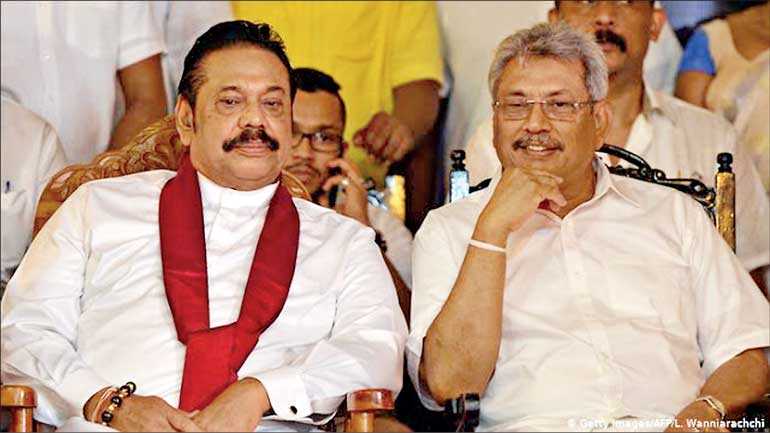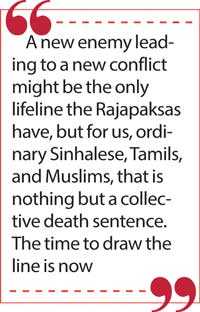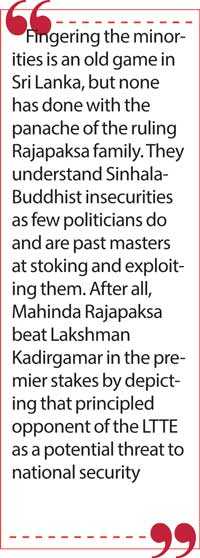Sunday Nov 24, 2024
Sunday Nov 24, 2024
Thursday, 14 January 2021 00:02 - - {{hitsCtrl.values.hits}}

The Gotabaya-Mahinda regime definitely has a split-personality: Jekyll to loyalists, Hyde to everyone else
“Now what’s going to happen to us without barbarians?
Those people were a kind of solution”
– C.P. Cavafy (‘Waiting for the Barbarians’)
By Tisaranee Gunasekara
A beleaguered president stages a phony war to rescue his political future.
So goes the plot of Larry Beinart’s 1992 novel, ‘American Hero’ and the 1997 movie it inspired, ‘Wag the Dog’.
Wag the dog is an Americanism; Merriam Webster traces it to 1858 play, ‘Our American Cousin’. The phenomenon it encapsulates though is universal and timeless – political leaders, from monarchs to republicans, from tyrants to democrats, using faux problems to hide real ones. The term gained an additional meaning after the movie: “superfluous (military) action in order to distract from domestic scandal.”
If Beinart’s novel borrowed from real life, reality would soon imitate fiction. In 1998, as the Monika Lewinski scandal was unfolding, President Bill Clinton launched a strike against a supposed terrorist target in Somalia. The destroyed complex turned out to be not a terrorist hideout but a pharmaceutical factory, set up with Western assistance.
After the White Supremacist insurrection in the Capitol, the US – and indeed the world – fears that Donald Trump might unleash a new war on his way out. America, a global power, can have its pick of ‘enemies’. India and Pakistan have each other; without the ‘air war’ of 2019, the BJP’s landslide victory might not have happened. Sri Lanka, being a small island, has no external enemy it can take on. To find a suitable enemy, its leaders must look inwards, to its ethnic and religious minorities. 
‘American Hero’ drew its characters from real life. Lee Atwater was described as someone who “had made brilliant and devastating use of innuendo, half-truth and political distortion to exploit the malignancies of American society, especially racism.”
Fingering the minorities is an old game in Sri Lanka, but none has done with the panache of the ruling Rajapaksa family. They understand Sinhala-Buddhist insecurities as few politicians do and are past masters at stoking and exploiting them. After all, Mahinda Rajapaksa beat Lakshman Kadirgamar in the premier stakes by depicting that principled opponent of the LTTE as a potential threat to national security.
Similarly, the ‘bury or cremate’ controversy is aimed at keeping the ‘Muslim threat’ in play. The issue shouldn’t exist, since according to known science burial is as permissible as cremation. This has been confirmed by experts like Prof Malik Peiris and Dr. Palitha Abeykoon (the new WHO envoy on COVID-19), and by reputed professional bodies, notably the Sri Lanka Medical Association (the oldest medical association in Asia and Australia) and the College of Community Physicians.
In an interview with American comedian Stephen Colbert, Barack Obama identified non-adherence to science as a key reason for Donald Trump’s ‘shambolic’ response to the pandemic. Similarly, politics and not science is at the root of the Rajapaksa refusal to permit burials.
As the pandemic continues to rage, and the regime’s incapacity to deal with it becomes manifest, scapegoats turn into political oxygen. Thus PM Mahinda Rajapaksa’s dictat – that if the experts committee recommends burial, then all COVID-19 dead should be buried (Lanka C News). What is this but an insidious attempt to keep the false controversy alive, pitting Buddhists against Muslims?
While the main focus is on burnishing the ‘Muslim enemy’, there are attempts to revive the Undead Tiger as well. Minister Sarath Weerasekara was reported arguing for laws to jail those who praise the LTTE, including Tamil parliamentarians (Lanka News Web – 18 December 2020). The police have filed a case against Jaffna’s Uthayan paper under the PTA for publishing a picture of Vellupillai Pirapaharan on his birthday (The Leader – 26 December 2020).
On the 8th night, the Army entered the Jaffna University and destroyed a memorial for the Mulliwaikkal war-dead. Did those who order this inane act of vandalism hope for a violent response from the student community? Were they aiming for visuals of heroic soldiers battling and defeating new Tigers? The way the State-owned ITN reported the story provides a hint – ‘Would-be-terrorist Jaffna students kneel before the STF’ (ITN News Breaking News). 
The peaceful resistance to the demolition (and perhaps the Tamil-Muslim unity on the issue) seemed to have discommoded the government. The memorial is to be rebuilt. Sanity has prevailed this time. But madness is in the air bringing with it the danger of a new war.
The post-war search for a suitable enemy – a brief history
The Rajapaksas search for a new enemy began soon after the long Eelam War ended.
The Government decision to not to reduce defence costs, post-war, dashed public expectation of a peace-dividend. By the second half of 2009, economic discontent was beginning to raise its clamorous head.
For example, workers in several key sectors, including the CEB and the Colombo Port, were threatening trade union action to win their demands, including oft-promised and long deferred pay hikes. Socio-economic issues had to be prevented from dominating the political space and public consciousness. An unending war against an ‘Undead Tiger’ was the regime’s chosen answer.
In August 2009, Gotabaya Rajapaksa stated the case. “Neither the President nor the Defence Secretary has stopped this war... The war will stop only after all the enemies who acted to the detriment of their motherland are brought to book...” (Indian Express – 11 August 2009). Barely three weeks later, on 30 August, the Colombo Crimes Division (CCD) discovered an explosive-laden van in Vavuniya, about to be sent to Colombo on a suicide mission. The Tiger indeed seemed undead and fighting fit.
Less than 24 hours later, DIG of the Northern Province (and former STF Commandant) Nimal Lewke dismissed the story as ‘suspicious and questionable’. The revelation that the CCD arrested the van but allowed the driver to go free was the final nail in the coffin of that particular vampire. The suicide van was not heard of again.
Flogging the dead Tiger would continue till 2013, in the absence of a more suitable alternative. For instance, in late 2011, in a lecture at the SLFI titled ‘Future Challenges to National Security in Sri Lanka,’ Gotabaya Rajapaksa identified a rejuvenated LTTE and pro-LTTE organisations here and abroad as the main enemy.
The Rajapaksas also toyed with the Christian enemy, trying to resuscitate the ‘conversion threat’. For example, in 2010, Premier D.M. Jayaratne proclaimed a Government plan to introduce five new acts to protect Buddhism, including an Anti-Conversion Bill. Though several organised mob attacks on Christian places of worship took place (including the burning of a new statue of Virgin Mary in a century-old Catholic church in Awissawella), the anti-conversion slogan did not fly the way it did in the early 2000s.
The Rajapaksa brand of acolyte capitalism (then as now a distorting mixture of economic neo-liberalism and statism) was exacerbating economic distress and the rich-poor divide. According to a Gallup Poll, in 2011 “about one half of Sri Lankans lacked money for food and shelter...”
In 2012, the Asian Development Bank warned that Sri Lanka’s poor “will suffer if prices of wheat and other commodities rise further” (Sri Lanka Mirror – 19 March 2012). While 56% of Lankans suffered from food shortages, Heritance, Ahungalle created the world’s most expensive cake, a culinary Petit Trianon (a la Marie Antoinette) featuring all members of the sapphire family and prized at $ 34 million.
The optics was bad, lived-reality worse. For the Rajapaksas, finding a suitable enemy was a matter of life and death, politically. The illegal impeachment of Chief Justice Shirani Bandaranayake was an added imperative. Since the Tamil enemy and the Christian enemy did not work, only one option remained: the Muslim enemy.
The delay in picking on the Muslims would have been due to several salient factors. A segment of the community still backed the Rajapaksas, electorally and financially. Muslim parties were part of the governing coalition. The regime enjoyed generous support of Muslim majority countries. Fingering the Muslims as the new enemy risked jeopardising all these benefits. Yet, faced by growing Sinhala discontent, the regime had little choice.
On 17 February 2013, the Muslim enemy was unveiled at an anti-Halal meeting in Maharagame. A new organisation, Bodu Bala Sena, was to lead the charge. Massive violence against the community followed, including the mini-pogrom in Aluthgama.
As Madille Pannaloka Thero, head of the Sinhala-Buddhist supremacist Sinha Le organisation (Lion’s Blood; the logo has the word Sinha in white and the word Le, meaning blood, in red) revealed in a recent interview, Gotabaya Rajapaksa had regular interactions with many an extremist monk before and after 2015.
The former Defence Secretary had a hand in the formation of Sinha Le and gave “little, little guidelines,” claimed the monk (https://www.youtube.com/watch? v=cL1t BVGUZf0&t=906s).
The anti-Muslim hysteria waned in the first 18 months of the Sirisena-Wickremesinghe administration, but gathered momentum again as economic discontents piled up. The resurfacing of the Muslim enemy was the work of the Rajapaksa opposition. The Government lacked the political will to resist the madness. It allowed the situation to spin out of control, a downhill path that led to Digana and then to the horrendous Easter massacre.
‘Strange case of Dr. Jekyll and Mr. Hyde’
“I am extremely fortunate to address you from the Sacred Precincts of the Ruwanweli Maha Seya in Anuradhapura, which enshrines the Sacred Relics of the Buddha,” said Gotabaya Rajapaksa commencing his maiden address as President. “I have received the opportunity of addressing the nation before the statue of great Warrior King Dutugemunu due to the historic mandate given to me by the majority of citizens.”
If King Dutugemunu is the hero-prophet of Sinhala-Buddhism, Ruwanweli Seya is its Mecca. Desecrating such a place should bring out robed and lay Sinhala-Buddhist supremacists in angry droves. Yet when a State Minister from Kandy acted in a manner that violated the sanctity of the place (he arrived, inebriated, around 11 p.m. on 5 December, demanded to be let in, and created an unseemly disturbance when refused permission) the only reaction was inaction. The Minister is a noted Rajapaksa loyalist.
The law seems blind to his crime while the self-anointed protectors of Sinhala-Buddhism are as mum as Thomson and Thompson.
In a recent outburst, President Gotabaya claimed that he has two characters (one nice and the other a tad murderous). If a man makes a claim for Split Personality (Dissociative Identity Disorder) then so be it. Gotabaya-Mahinda regime definitely has a split-personality: Jekyll to loyalists, Hyde to everyone else.
All charges against Parliamentarian Pillayan have been withdrawn (accused of masterminding the murder of an unarmed man in a church during the Midnight Mass on Christmas Eve). Meanwhile Hejaaz Hisbullah’s detention has been extended for 90 more days. The cops who tried to fabricate evidence against him in the presence of a magistrate remain free while Shani Abeysekara and his two colleagues continue to be incarcerated, accused of fabricating evidence.
Weddings of normal people are restricted to 50 guests (a necessary precaution) while the Speaker holds a budget party with nearly 500 guests. Lankans are punished for being mask-less while Ukrainian tourists trafficked by Rajapaksa cousin Udayanga Weeratunga roam mask-less. (Ukraine with a population of only 40 million has an official infection count of one million and is currently in lockdown).
A seemingly gossamer-skin President Gotabaya invoked the killing of Vellupillai Pirapaharan in response to Parliamentarian Harin Fernando calling him by his first given name. Had we been in the throes of a new war, Fernando could have been accused of some kind of treachery (ordered biriyani too many times, perhaps?).
Wars not only enable leaders to divert public attention from socio-economic woes; they also make it easier to target political opponents. Lasantha Wickrematunge was murdered one week after the fall of Kilinochchi and one day before the taking of Elephant Pass.
“Societies that shrink from, fictionalise or paper over the uglier parts of their past invite even uglier episodes,” wrote US columnist James Fallows (The Atlantic – 10 January 2021). We, Lankans, have our share of ugly history to reckon with, a history that predates the Rajapaksas by many decades. We know what wars, pogroms, and suicide bombings do. We have paid the price in lives and property, blood and tears, again and again.
After the 1958 anti-Tamil riots, Tarzie Vittachchi asked, “What are we left with? A nation in ruins, some grim lessons which we cannot afford to forget and a momentous question: Have the Sinhalese and Tamils reached the parting of ways?” (quoted in ‘Tigers of Sri Lanka’ – MR Narayan Swami). We forgot the grim lessons, didn’t ask the momentous questions and ended with a 30-year war.
A new enemy leading to a new conflict might be the only lifeline the Rajapaksas have, but for us, ordinary Sinhalese, Tamils, and Muslims, that is nothing but a collective death sentence. The time to draw the line is now.